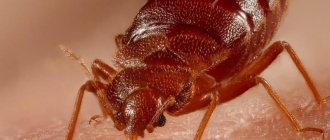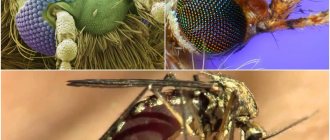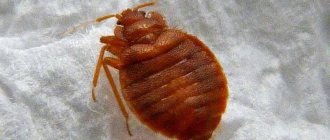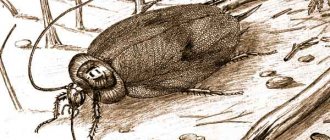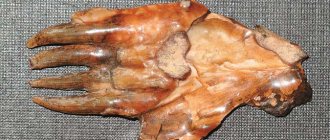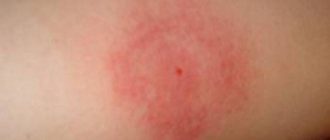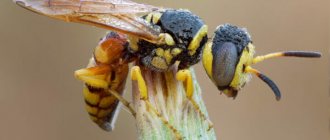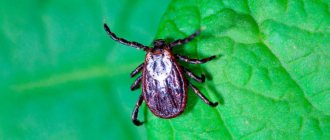How mosquitoes appear, where life begins
The first generation of bloodsuckers emerges from the pupa in May. After mating, the female mosquito immediately begins laying eggs. They develop in water or damp soil. In urban environments, this occurs on sewer pipes and basement walls.
Stages of mosquito development:
- egg;
- larva;
- chrysalis;
- imago.
The transformation lasts from 20 days to several months.
Under favorable conditions, the larvae are born within 9 hours. Outwardly they resemble a small worm, a caterpillar. Brown-gray color. There are special spiracles on the body that allow them to dive under water. Nutrition occurs through water filtration. During the day, this small creature passes up to 1 liter of water through itself, removing various microorganisms.
The full cycle of development and life of a mosquito larva lasts 7-20 days. During this time, several moults occur and the body increases in size. At the last stage, pupation occurs. The mosquito pupa is also in the water. He doesn't eat anything, he barely moves. The most complex processes take place inside, and after a few days the imago appears. It breaks through the cover of the cocoon, revealing the head, the upper part of the body, then the abdomen and legs.
Interesting!
How mosquitoes are born and their life begins, nature lovers filmed. The video can be viewed below. The spectacle is funny and interesting.
The pupae that formed at the end of summer freeze and remain for the winter. In this state, the larva can exist for about 11 months. In areas where the warm season lasts only a couple of months, mosquitoes manage to give life to only one generation.
How and where mosquitoes overwinter in nature and in human homes
Typically, the life cycle of a mosquito begins and ends in nature. Adult insects and their larvae, which have not completed the full development cycle, are capable of falling into torpor with the onset of the first frost and until a steady spring thaw. They spend the winter in cracks in the bark or under a layer of fallen leaves, in vegetable stores, and outbuildings. In tropical forests, mosquitoes live and breed all year round.
In an apartment, the mosquito feels quite good, especially if there are secluded, damp corners where it can comfortably and safely wait for the right moment to attack household members. But if the female managed to get into a person’s house, then after the bite she, as a rule, soon tries to get outside and find a wet pond for laying larvae.
However, the female can lay larvae right in or near the house, for example, in a barrel where water for watering beds settles, in a water trough for livestock, or in a damp basement. In warm and humid basements of residential buildings, the population of these blood-sucking insects can be renewed and exist all year round.
How long do mosquitoes live?
During the mating season, the female mosquito becomes an aggressive bloodsucker. She needs blood to procreate. How many years mosquitoes live depends on the following factors:
- Thermometer indicators.
- Areas of residence.
- Presence of blood.
It is the air temperature and the opportunity to feed that prolong the life of the mosquito. Optimum temperature +10 degrees. As the thermometer reading increases, life expectancy decreases.
Availability of food is also important. How long does a common mosquito live after biting a person? Up to 119 days. It is the blood that helps the female lay eggs, stocking up on nutrients. If there is no blood, then the exhausted organism gives up all its energy to its descendants, and the insect dies. Therefore, when answering the question of how long mosquitoes live after a bite, it is important to know that the more opportunities there are to eat, the longer the bloodsucker will live.
To summarize, let’s find out how long the insects in the table live, provided they have a constant source of food. We take females into account, because we are interested in how long a female mosquito lives.
| Air temperature | Length of stay, days |
| 25°C | Up to 43 |
| 20°C | Up to 58 |
| 15°C | Up to 114 |
| 10°C | Up to 119 |
Finding out how many days mosquitoes live, it turns out that the lower the temperature, the longer. Despite this, mosquitoes are heat-loving. That’s why in an apartment they often sit on the ceiling, where the air temperature is higher and where it’s difficult to reach with slippers.
Interesting points
From 3 months to 1 year - this is how long a mosquito lives, depending on its habitat conditions. He endures winter in a state of torpor. The insect prefers to live near bodies of water with standing water. This is where mosquitoes feel most comfortable. They also like:
- marshy areas;
- shady forests;
- lowlands.
In this video you will learn interesting facts about mosquitoes:
Preference is given to these places due to the developmental characteristics of the larvae. The common mosquito was able to become most widespread. It is he who most often attacks people. The main distribution season is in summer. How many days mosquitoes live depends on conditions such as:
- Availability of a food source. Males prefer plant foods and feed on plant nectar. Only females feed on blood. Females attack fish, amphibians, animals and humans.
- Ambient temperature. The range from +10°C is considered comfortable. The female can exist in such conditions for about 3 months. She lives for 2 months if the temperature rises to 20 degrees Celsius. The life of a female lasts no more than 40 days when the temperature exceeds +25°C. Under the same conditions, males live 2 times less.
- Availability of a comfortable living environment. This refers to a favorable level of humidity. For the same reason, winged insects often choose cold utility rooms - rooms, damp basements.
- The presence of enemies nearby. These are birds, insectivores, humans.
Lifespan of the common mosquito
Female squeaker mosquitoes live approximately twice as long as males, although the lifestyle of males is associated with much lower risks to life. In this type of insect, males feed exclusively on plant nectar, while females vitally need blood during the breeding season, and they are constantly at risk of being killed when biting, because for the victim their bite does not go unnoticed.
Many females die just during the meal, but under favorable circumstances they are able to live up to 4 months (excluding the stage of larval development and possible hibernation) and give birth to numerous offspring. For an extremely long life, in addition to the availability of food, humidity and a certain temperature regime are also required.
So, the female will live a maximum:
- 43 days at t +25°C;
- 58 days at t +20°C;
- 114-119 days at t +10..+15°C.
The life of a male mosquito at the same temperatures, accordingly, will be half as long as the indicated periods, but most often it does not exceed 20 days at all. While the life of a female can last 1 year in total.
At temperatures below +10°C, mosquitoes become inactive, and at 0°C they fall into torpor. And the onset of heat and drought sharply reduce the population of these insects.
Mosquitoes live mainly in shady, humid forests, near swamps and any bodies of water, especially standing and weak-flowing ones, which they need to breed offspring.
How many days a mosquito will live is also affected by the number and activity of insectivorous birds and the predatory insects that feed on them. In nature, mosquitoes try to hide in dense vegetation, because in open areas they have nowhere to hide from their pursuers.
What determines the lifespan of mosquitoes - a list of factors
Most female Culex mosquitoes live from two weeks to a month. Males have a less enviable lot - they get to enjoy life from several days to three weeks maximum. By the way, in recent decades, entomologists have noted a reduction in the life span of mosquitoes and at the same time an increase in their fertility. Perhaps this became a form of reaction to man's desire to eradicate harmful insects.
Life expectancy is directly affected by the characteristics of the mosquito’s habitat:
- temperature of air and water necessary for reproduction;
- daily temperature changes and frosts;
- the presence of vegetation cover in which insects hide from the heat of the day;
- activity of natural enemies - predatory insects, fish, small birds, amphibians.
Life and death of a mosquito
As a rule, the main causes of death of mosquitoes are the following factors:
- Temperature too high;
- Excessive saturation;
- Extreme cold;
- Hunger;
- Old age of the individual;
- Attack of an insectivorous creature.
Insects are simply not able to survive at high temperatures, so in the summer sun they try not to leave their shelters. Hunting begins in the evening and at night. The basic rule is that the temperature should not exceed 25 degrees. If the air heats up to 50 degrees, then mosquitoes may even die. Taking into account the above, be prepared for pest attacks at night: install fumigators or repellers, use special protective creams and sprays. This type of mosquito control is always effective and will help avoid bites.
Lifespan of an insect after a bite
The mouthparts of a mosquito are fundamentally different from the female, which has sharp fangs for piercing the skin and sucking blood from a person or warm-blooded animal.
Some species are able to feed on the blood of even fish, birds and amphibians. An unfertilized female, like males, feeds exclusively on plant foods.
Insects can lay eggs without blood. But in this case, immediately after oviposition, the female dies in one day, and less than half of the weak offspring survive.
Thus, if a source of protein nutrition is in close proximity, the female will be able to regularly replenish the necessary reserves of expended energy and live her full life cycle after a human bite, that is, at least 4 months.
How long can a mosquito live without blood?
Males and females, eating only plant foods, can live to their maximum lifespan. But in order to lay eggs, the female needs protein and lipids. She receives them from the blood of mammals, including humans. Until a protein source of nutrition is found, she will not be able to lay eggs. Having bitten the victim, it fills its abdomen with blood and flies off to a quiet place to form eggs.
This is interesting! Females of some mosquito species can reproduce without feeding on blood. But the lack of protein food leads to a decrease in the number of eggs laid.
How long does a female mosquito live without blood and after a bite?
The statement that mosquitoes die almost immediately after being bitten is fundamentally contrary to the truth. The better a female mosquito eats, the longer she lives. She needs blood not only to maintain strength, but also to form strong offspring. The female, saturated with blood, will lay many eggs, from which new tenacious insects will be born.
Without blood, the female's life is shortened several times. If after fertilization the female was unable to bite anyone, she will still lay eggs, but they will develop into weak offspring, most of which will simply die. After this, the female herself will most likely also die, because her body will give up its last strength to the offspring.
Cycle and duration of larval development
The female is capable of biting every few hours. The eggs in her abdomen are formed as she digests a portion of the blood she drinks. Every 2-3 days, the mosquito lays eggs in the water of a suitable body of water (including puddles), on plants or in moist soil.
At one time, the mosquito lays 20-300 eggs, from which larvae develop in about 2-8 days. The larva pupates after 20 days, and after a few more days an adult mosquito emerges from the pupa.
Does a mosquito die after biting a person?
It is not true. As shown above, females consume blood as a building material for eggs, and mainly human blood. Since the egg laying cycle is two or three days, it is advisable to drink blood as often as possible. Therefore, we can state the opposite: the more often a female bites people, the longer she lives and the healthier her offspring are. And so, biting a person does not shorten the lifespan of mosquitoes. How long do mosquitoes live in a cartir after they bite?
There are many factors that influence this, for example:
- ambient temperature;
- the presence of food in the form of sweet plant juice and human blood;
- the location of bodies of water where mosquitoes can breed;
- the presence of predators that love to feast on mosquitoes; other factors, for example, chemical emissions.
In general, males live half as long as females, which is quite surprising, since females, when sucking blood, risk being killed much more often.
The life of mosquitoes depends most of all on the weather: at zero degrees they fall into torpor, and they have this life expectancy depending on temperature (data for the female, the life of the male is half as long):
- at 25 degrees and above - 41-45 days;
- 20 degrees - 56−60;
- 15 degrees - 114−119;
- 10 degrees - 114−119.
So, under favorable conditions, a female can live 4 months, the absolute record is about a year, the life of a male is half as long.
You can watch a video that tells how long a mosquito lives after biting a person.
On average, the life of a mosquito is somewhat shorter, because some of them are eaten by predators: dragonflies, swallows, predatory species of flies, bats, and some species of frogs. And, of course, many females die from human bites. So, does a mosquito die after being bitten? Only if the man himself killed him.
How does he breathe?
At the end of the body of mosquito larvae there is a special process - this is the breathing tube. This part is required for the respiration of organisms. They swim to the surface of the reservoir and stick out a tube through which oxygen enters. The respiratory system is common among common mosquitoes.
There are mosquito larvae that receive dissolved oxygen. They absorb it through the surface of the body. Species live at depth; they rarely swim to the top of the water.
The larvae that live at the bottom of reservoirs have special gill filaments, with the help of which they can receive a sufficient amount of oxygen.
Mosquito larvae are an important stage in the development of insects. During it, systems and internal organs are formed that will be required for the further development of parasites. It takes about two weeks, then the pupal stage begins, from which the imago or adult emerges.
In order for a healthy mosquito to form from a larva, many important conditions must be met, which will subsequently affect the growth and formation of the internal system of the bloodsucker.
How long can they live without bleeding?
The lack of blood does not affect the life expectancy of males. The female needs such food only before breeding; if she does not eat, she can live for a maximum of 2 days after laying eggs. Thus, the life of individuals without blood is affected only by temperature. The mosquito is able to hibernate in the bark of trees or indoors; during cold times it goes into diapause, during which the metabolism is slowed down; with the onset of warmth, the individual wakes up again. Thus, suspended animation can prolong the life of a female up to 1 year.
Can mosquitoes carry diseases, HIV, hepatitis C?
Today you can hear information that these insects are capable of transmitting a disease such as hepatitis. Scientists have conducted a number of studies, their results are as follows:
- It is almost impossible to become infected with this particular disease.
- The viruses of this disease “live” in the blood, and when a mosquito bites its victim, it injects it exclusively with its saliva.
- The insect's mouthparts are designed in such a way that blood can only be sucked inwards, after which the bloodsucker cannot throw it out.
- The same situation occurs with HIV. Moreover, this insect simply will not be able to transmit the required amount of virus to a person for infection.
- Regarding other diseases that were described earlier, things are different. Mosquitoes can easily infect the people they bite with them.
How long does a mosquito live in an apartment?
When answering the question of how long mosquitoes live, it is worth considering that indoors are good conditions for the entire life cycle of a mosquito. After 2-3 days, a mosquito emerges from the egg, and after a week it turns into an adult, ready to reproduce and enjoy life.
At one time, the female lays 30-150 eggs. If the temperature is +10 and there is a constant source of food, then the mosquito’s life cycle can become continuous. When the temperature rises to +25, the lifespan of mosquitoes is tamed.
Eggs thrive in dark, damp places. Answering the question of how many years a mosquito lives, we can say 3 months. If a female mosquito appears in the apartment, then having access to blood, she will lay eggs in the bathroom, toilet or pantry, providing company for the entire summer period.
How long can mosquitoes live
Many people ask this question not just for fun. Red itchy blisters on the body are a clear sign of a night attack by “bloodsuckers”. Having discovered such traces, people begin to carefully search for the “offender.” When the search turns out to be in vain, the question arises: perhaps the mosquito has already died? However, one can hardly hope for this. He just hid himself well.
In general, a person’s home is an ideal place for mosquitoes. Here the humidity and temperature are quite comfortable. And my favorite delicacy, human blood, is always nearby. The favorite place of mosquitoes is the ceiling. This is explained by the fact that warm air collects there, in which they feel as comfortable as possible.
There is an opinion that since mosquitoes do not like cold air, they do not rise to a height of more than eight meters. Following from this assumption, we can conclude that residents of the upper floors of multi-story buildings can safely open windows even in summer. However, in practice everything looks different. Even residents of the sixteenth floors suffer from the invasion of these “bloodsuckers”, so they are forced to install mosquito nets. This can be explained by the fact that mosquitoes consciously fly to such a height in order to climb into a warm human home.
It is worth noting that installing mosquito nets on windows does not guarantee that mosquitoes will not enter your home. Insects use sewer pipes and ventilation ducts for these purposes. They skillfully penetrate from the entrance. If a mosquito sits motionless on the front door, a person does not notice it. As soon as the door opens into the apartment, the mosquito immediately flies in. A mosquito can live here for quite a long time, leaving offspring. Favorite places for laying eggs are drain siphons, which are always humid.
Where do parasites come from in an apartment?
Many readers wonder where a mosquito can come from in a city apartment if the nearest body of water is several dozen kilometers away. As noted in the previous section, mosquitoes are capable of flying hundreds of kilometers in search of prey. In addition, our domestic mosquitoes, which have easily adapted near humans, do not require a swamp or river at all. A puddle in the shade or basement of a house, as well as thick wet grass, is quite enough.
Insects enter a city apartment directly only through open windows, doors or ventilation shafts.
They have no other ways here. There is an opinion that mosquitoes do not rise above the third floor. It's a delusion. The hovering altitude of a mosquito is greatly influenced by the atmospheric pressure at the current time and the static altitude at sea level. The higher above sea level and the lower the atmospheric pressure at a certain storey line, the more effective the overcoming threshold for mosquitoes it will be. For this reason, in some foothills and mountainous areas there are no mosquitoes at all.
Residents of rural areas were a little less fortunate. In addition to the fact that insects also fly into doors and windows, they also hatch directly under the floor, in cellars and so on, especially if there is a lot of dampness here. They also successfully fly into rooms through open vents. From there, on cool evenings, heat comes out, which female mosquitoes feel very well, so they fly towards the warm air, ending up in the very heart of the room.
Daylight blinds insects, especially the upper ultraviolet range, for which their vision is not adapted. Therefore, insects attack mainly in the morning and evening twilight or at night.
Where do mosquitoes live?
Natural habitat, life - forest, swamp, lake, any reservoirs, peat bogs. In urban areas, insects are found in basements, entrances, near garbage cans, sewage pits, and grass. They often sneak into apartments and houses through cracks, open windows, and doors.
Mosquitoes die at temperatures above 25 degrees Celsius from dehydration. At low levels they go into suspended animation. In what month do they disappear and stop flying - in June, when the temperature rises, in August. However, in wetlands, mosquitoes can live permanently throughout the summer. They will disappear completely in the fall. The mosquito season in the Moscow region begins in May and ends in September.
On a note!
The mosquito family appears almost simultaneously with the midges. The former are active in the evening, the latter during the day. The lifespan of midges and mosquitoes is somewhat different. The midge flies for no more than 1 month. They begin to disappear in mid-June. During a drought, they may die earlier or not appear at all.
What are the characteristics of the common mosquito?
Mosquitoes appear near bodies of water, where the female can simultaneously lay up to 300 eggs. It takes them about 8 days to form a larva, but they turn into a full-fledged adult only after another 25 days. And within a week they are ready to reproduce.
Mosquitoes live everywhere except in the Arctic territories. The total number of species is about 3 thousand. The optimal temperature for life is around +16°C. The preferred habitat is areas with increased humidity.
The squeak, which sometimes drives people crazy at night, is nothing more than the sound of flapping wings that move at a speed of 600 beats per second.
Mosquitoes can be seriously dangerous to humans. A banal bite can cause deadly diseases such as tularemia, lymphatic filariasis, etc.
How to fight mosquitoes?
There are many ways to protect yourself and your home from mosquitoes. Let's consider the 3 most extensive areas:
- Traditional methods.
- Repellents.
- Insecticides.
- Ultrasonic traps.
Traditional methods involve the use of various plants, herbs and infusions that will repel insects. They are not very effective, but, nevertheless, you should not completely abandon them. Folk remedies can be combined, for example, with repellents.
Repellents are specialized products aimed at protecting against mosquitoes. They repel but do not kill insects. There are repellents for both people and animals. Depending on the age and sensitivity of the skin, you can choose different types of repellents: for children, for people with sensitive skin, for allergy sufferers, etc.
Insecticides, unlike repellents, not only repel, but also destroy mosquitoes. Insecticides have many contraindications. As a rule, they cannot be used indoors. They should only be applied to clothing in an open space. It’s a different matter when it comes to “Raptor” insecticides and analogues. They are safe for humans, however, they are contraindicated for use if there are animals or aquarium fish in the house.
Ultrasonic traps are mechanical devices. After connecting them to the network, they begin to emit ultrasonic waves, thereby repelling mosquitoes.
Mosquitoes in drainpipes
If you suspect mosquitoes are living or laying eggs in your home's drainage system, there are several ways to get rid of these blood-sucking insects. First, try pouring a cup of vinegar down the drain and then cover the drain with a rag soaked in vinegar. This needs to be done for at least a few hours, but better all day if you can stand the strong smell of vinegar. Then rinse the drain thoroughly with hot water.
What is the name of
Larva is the main name, but organisms also have other names. The word midge is often used in books; it is a common name.
Fishermen and ornamental fish breeders call mosquito larvae bloodworms. They use them for feeding. But they are still considered a type of larvae. They are also called bells, chironomids or longhorns.
There is another name - it is a squeak mosquito, which looks like a worm. A squad of insects is located closer to the bottom of a container or reservoir with standing water.
Bloodworms are still considered a type of larvae. Its body is bright red, this is due to the content of hemoglobin. It has good vitality and is able to survive in any natural conditions.
Lives at the bottom of a reservoir, builds a house from silt, which looks like a tube. It serves as a kind of shelter from various dangers; the bloodworm sticks out only the front part of it to search for food.
Mosquitoes that are used to feed ornamental fish are called corets. In malaria mosquitoes they are called anopheles.
Let's sum it up
So, we found out that the common mosquito lives on average 42-56 days (female) and 10 days (male). A mosquito that has drunk blood continues its life cycle and does not die, as some believe. In an apartment or any other unnatural living conditions, mosquitoes live less. There are various ways to combat them: traditional methods, repellents, insecticides and ultrasonic traps.
Sources
- https://notklop.ru/komary/o-komarah/skolko-zhivet-komar/
- https://fumigatservis.ru/skolko-zhivet-komar-obyknovennyj/
- https://vrediteli24.ru/sad-i-ogorod/skolko-zhivet-komar.html
- https://MosquitoMagnet.ru/articles/fakty-iz-zhizni-komarov/dlitelnost-zhizni-komara.html
- https://vermins.net/komary/skolko-zhivet-komar.html
- https://jivovred.com/naprirode/prodolzhitelnost-zhizni-komarov
- https://KlopSOS.ru/komary/prodolzhitelnost-zhizni-komarov-v-razlichnyh-usloviyah/
- https://mymedic.clinic/biologicheskie/skolko-zhivet-komar-posle-ukusa.html
- https://TaraKlop.ru/komary/skolko-zhivut-komary/
- https://NatWorld.info/vopros-otvet/skolko-zhivut-komary-chto-ih-privlekaet-v-dom-i-kak-ot-nih-izbavitsja
- https://StopKlopam.com/skolko-zhivut-komary/
- https://bez-klopa.ru/komaryi/skolko-dney-zhivet-komar-posle-ukusa-cheloveka/
Interesting facts about mosquitoes
Despite the fact that few people like mosquitoes, their lives are full of interesting things. And if we consider these insects not as bloodsuckers, then the interest in them will be much stronger.
- Mosquitoes have a unique daily routine. During the day, these creatures rest, hiding not only from the bright rays of the sun, but also from other animals that feed on them.
- There is information that this is exactly the number of mosquitoes – 1,200,000 – needed to drink all the blood from a person.
- Many people do not know the fact that only female mosquitoes drink blood and bite, however, this is true.
- Initially, mosquitoes were called flies, in principle, like all other dipterous insects.
- Mosquitoes are able to smell prey at a distance of several tens of meters.
As you can see, mosquitoes are not only constantly disturbing squeaking creatures. These insects benefit both humans and all living nature. Moreover, the death of these insects will lead to irreversible processes, so it is impossible to deliberately exterminate them.
